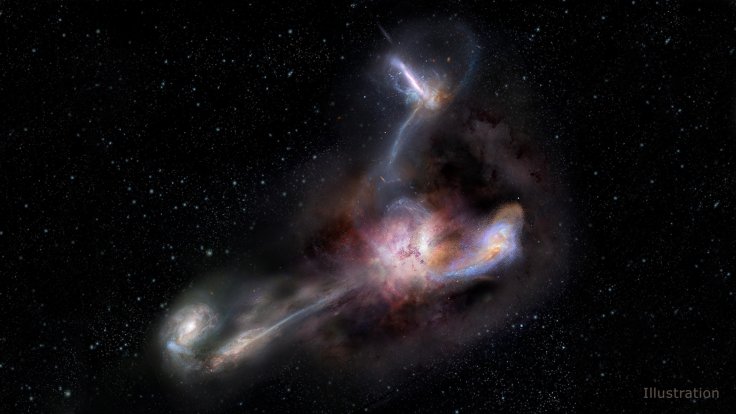
A new study report published in the journal Science has revealed that the discovery of the most luminous galaxy that is cannibalizing its three neighbours.
The study co-authored by NASA scientists at the Jet Propulsion Laboratory in Pasadena, California along with scientists in Chile also suggested that the material stolen by the galaxy from its neighbours is primarily responsible for its brightness.
This galaxy dubbed WISE J224607.55-052634.9 was discovered by NASA's space-based Wide-field Infrared Survey Explorer (WISE) way back in 2015. Even though WISE J224607.55-052634.9 is not the largest or massive galaxy in the universe, it is now radiating 350 trillion times the luminosity of the sun. If all the galaxies are positioned equally, then WISE J224607.55-052634.9 would be seen brighter when viewed from the earth.
Scientists discovered cannibalizing nature of this galaxy while analyzing its properties using the Atacama Large Millimeter/submillimeter Array (ALMA) in Chile. During the research, the study team noted distinct trails of dust being pulled from three smaller galaxies into WISE J224607.55-052634.9. It should be noted that the trails contain materials from these three smaller galaxies, and WISE J224607.55-052634.9 is quickly eating all these particles to make it more luminous.
Scientists are still unclear whether these victim galaxies will escape their current fate or will they be completely eaten up by their brightly shining neighbour.
"It is possible that this feeding frenzy has already been ongoing for some time, and we expect the galactic feast to continue for at least a few hundred million years," said Tanio Diaz-Santos, a researcher at the Universidad Diego Portales in Santiago, Chile, and the lead author of the study in a recent statement.
It is not only the stars that are resulting in the massive brightness of this galaxy. The galaxy has a collection of hot gas and dust concentrated around the centre, and at the heart of this cloud, a supermassive black hole is located. This supermassive black hole is four billion times more massive than the sun, and when matter falls inside this black hole, it gets heated up millions of degrees. This increase in temperature causes the materials to shine, and this is another reason behind its incredible brightness.








